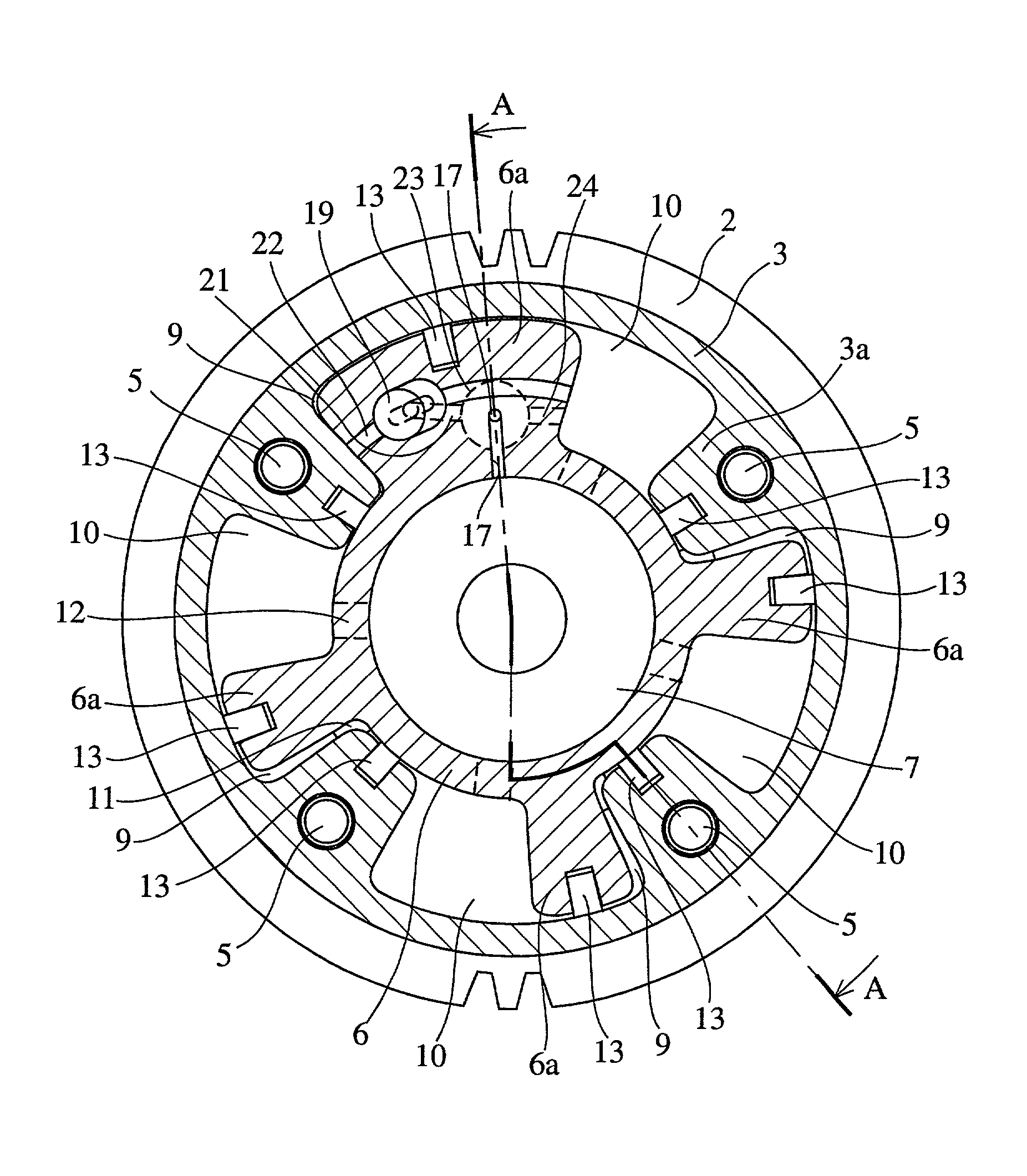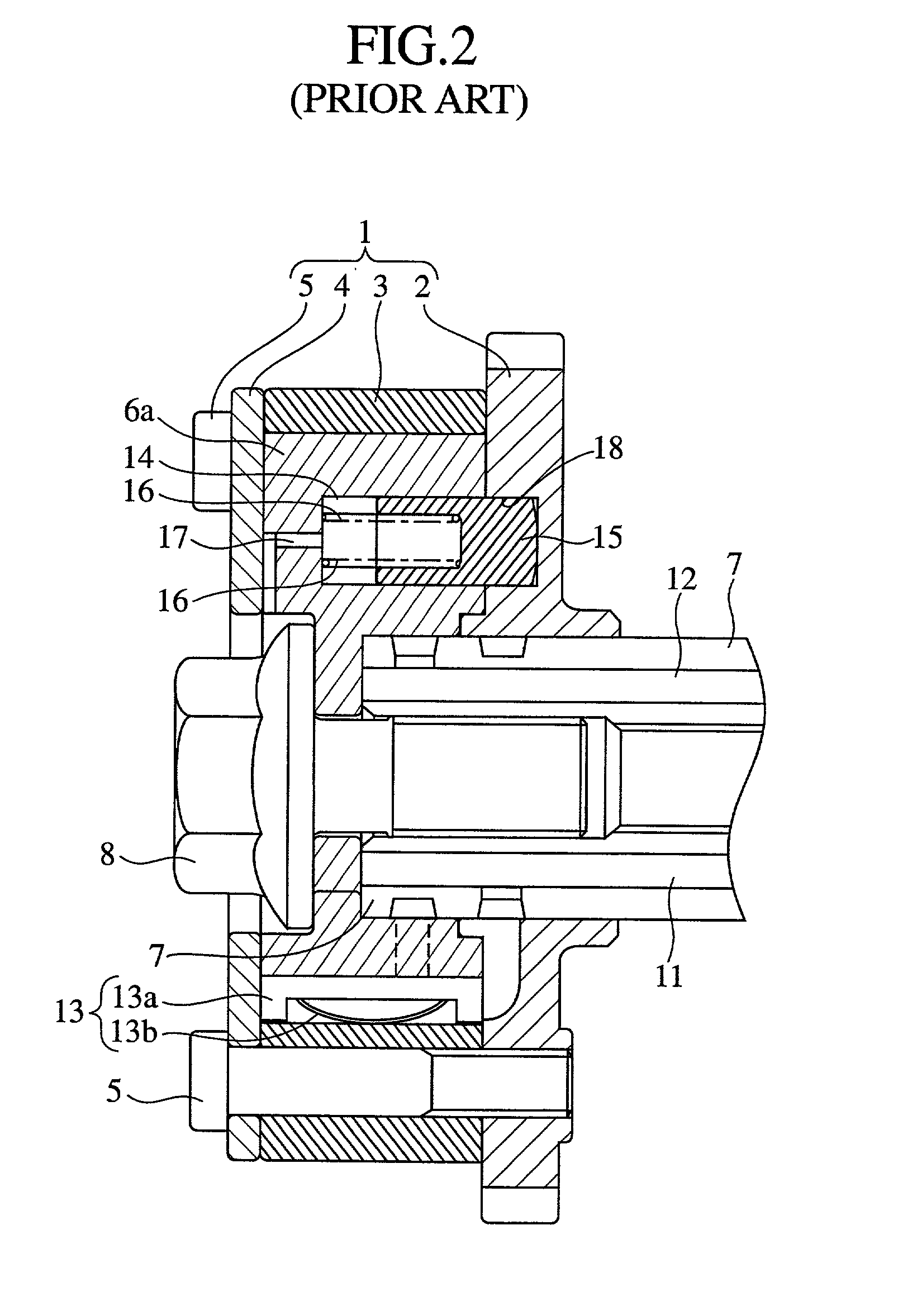Valve timing control device
a timing control and valve technology, applied in valve arrangements, machines/engines, mechanical equipment, etc., can solve the problems of difficult to prevent the occurrence of beat noise, repeating beat noise, and remaining air in the spective hydraulic chamber
- Summary
- Abstract
- Description
- Claims
- Application Information
AI Technical Summary
Benefits of technology
Problems solved by technology
Method used
Image
Examples
embodiment 1
[0063] FIG. 6 is a lateral cross sectional view of an internal construction of a valve timing control device as embodiment 1 according to the present invention. FIG. 7 is a longitudinal cross sectional view taken along lines A-A of FIG. 6. FIG. 8 is an enlarged perspective view of a locking / unlocking mechanism of the valve timing control device shown in FIG. 6 and FIG. 7. FIG. 9A and FIG. 9B are longitudinal cross sectional views of an operation of the locking / unlocking mechanism of the valve timing control device shown in FIG. 6 to FIG. 8, FIG. 9A shows a locked state and FIG. 9B shows an unlocked state. FIG. 10 is a graph of a relationship between an operational stroke of a locking member of the locking mechanism of the valve timing control device shown in FIG. 6 to FIG. 9B and a hydraulic pressure exerted on the locking mechanism. Components of the embodiment 1 common to those of the conventional valve timing control device shown in FIG. 1 to FIG. 5 are denoted by the same refere...
embodiment 2
[0087] FIG. 11 is a perspective view of an important part of a locking / unlocking mechanism of a valve timing control device as embodiment 2 according to the present invention. FIG. 12A and FIG. 12B are longitudinal cross sectional views of an operation of the locking / unlocking mechanism of the valve timing control device shown in FIG. 11, FIG. 12A shows a locked state and FIG. 12B shows an unlocked state. FIG. 13 is a graph of a relation ship between an operational stroke of a locking member of the locking mechanism of the valve timing control device illustrated in FIG. 11 to FIG. 12B and a hydraulic pressure exerted on the locking member. Components of the embodiment 2 common to those of the conventional valve timing control device shown in FIG. 1 to FIG. 5 or those of the embodiment 1 are denoted by the same reference numerals and further description will be omitted.
[0088] The embodiment 2 is characterized in that a locking pin 25 defined as the tier-equipped pin is used, whereas ...
embodiment 3
[0103] FIG. 14 is a lateral cross sectional view of an internal construction of a valve timing control device as embodiment 3 according to the present invention. FIG. 15 is a perspective view of an important part of a locking / unlocking mechanism of the valve timing control device shown in FIG. 14. FIG. 16A and FIG. 16B are longitudinal cross sectional views of an operation of the locking / unlocking mechanism of the valve timing control device shown in FIG. 14 and FIG. 15, FIG. 16A shows a locked state and FIG. 16B shows an unlocked state. Components of the embodiment 3 common to those of the conventional valve timing control device shown in FIG. 1 to FIG. 5 or those of the embodiment 1 are denoted by the same reference numerals and further description will be omitted.
[0104] With the embodiment 3, a third unlocking hydraulic pressure supply path 28 is disposed at the vane 6a of the rotor 6 and a fourth unlocking hydraulic pressure supply paths 29 is disposed at the sprocket 2, instead...
PUM
 Login to View More
Login to View More Abstract
Description
Claims
Application Information
 Login to View More
Login to View More - R&D
- Intellectual Property
- Life Sciences
- Materials
- Tech Scout
- Unparalleled Data Quality
- Higher Quality Content
- 60% Fewer Hallucinations
Browse by: Latest US Patents, China's latest patents, Technical Efficacy Thesaurus, Application Domain, Technology Topic, Popular Technical Reports.
© 2025 PatSnap. All rights reserved.Legal|Privacy policy|Modern Slavery Act Transparency Statement|Sitemap|About US| Contact US: help@patsnap.com



